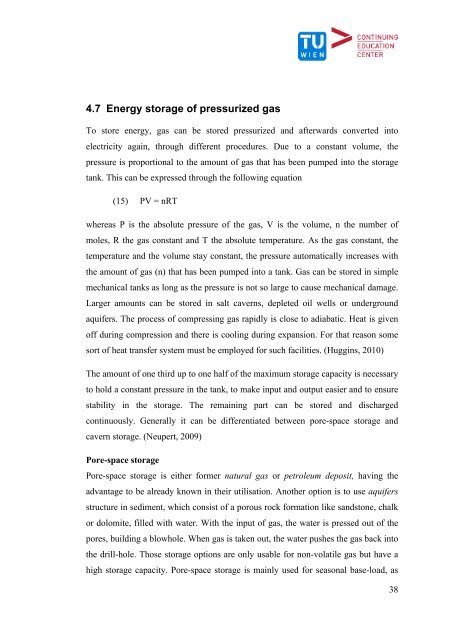The relevance of energy storages for an autarky of electricity supply ...
The relevance of energy storages for an autarky of electricity supply ...
The relevance of energy storages for an autarky of electricity supply ...
You also want an ePaper? Increase the reach of your titles
YUMPU automatically turns print PDFs into web optimized ePapers that Google loves.
4.7 Energy storage <strong>of</strong> pressurized gas<br />
To store <strong>energy</strong>, gas c<strong>an</strong> be stored pressurized <strong>an</strong>d afterwards converted into<br />
<strong>electricity</strong> again, through different procedures. Due to a const<strong>an</strong>t volume, the<br />
pressure is proportional to the amount <strong>of</strong> gas that has been pumped into the storage<br />
t<strong>an</strong>k. This c<strong>an</strong> be expressed through the following equation<br />
(15) PV = nRT<br />
whereas P is the absolute pressure <strong>of</strong> the gas, V is the volume, n the number <strong>of</strong><br />
moles, R the gas const<strong>an</strong>t <strong>an</strong>d T the absolute temperature. As the gas const<strong>an</strong>t, the<br />
temperature <strong>an</strong>d the volume stay const<strong>an</strong>t, the pressure automatically increases with<br />
the amount <strong>of</strong> gas (n) that has been pumped into a t<strong>an</strong>k. Gas c<strong>an</strong> be stored in simple<br />
mech<strong>an</strong>ical t<strong>an</strong>ks as long as the pressure is not so large to cause mech<strong>an</strong>ical damage.<br />
Larger amounts c<strong>an</strong> be stored in salt caverns, depleted oil wells or underground<br />
aquifers. <strong>The</strong> process <strong>of</strong> compressing gas rapidly is close to adiabatic. Heat is given<br />
<strong>of</strong>f during compression <strong>an</strong>d there is cooling during exp<strong>an</strong>sion. For that reason some<br />
sort <strong>of</strong> heat tr<strong>an</strong>sfer system must be employed <strong>for</strong> such facilities. (Huggins, 2010)<br />
<strong>The</strong> amount <strong>of</strong> one third up to one half <strong>of</strong> the maximum storage capacity is necessary<br />
to hold a const<strong>an</strong>t pressure in the t<strong>an</strong>k, to make input <strong>an</strong>d output easier <strong>an</strong>d to ensure<br />
stability in the storage. <strong>The</strong> remaining part c<strong>an</strong> be stored <strong>an</strong>d discharged<br />
continuously. Generally it c<strong>an</strong> be differentiated between pore-space storage <strong>an</strong>d<br />
cavern storage. (Neupert, 2009)<br />
Pore-space storage<br />
Pore-space storage is either <strong>for</strong>mer natural gas or petroleum deposit, having the<br />
adv<strong>an</strong>tage to be already known in their utilisation. Another option is to use aquifers<br />
structure in sediment, which consist <strong>of</strong> a porous rock <strong>for</strong>mation like s<strong>an</strong>dstone, chalk<br />
or dolomite, filled with water. With the input <strong>of</strong> gas, the water is pressed out <strong>of</strong> the<br />
pores, building a blowhole. When gas is taken out, the water pushes the gas back into<br />
the drill-hole. Those storage options are only usable <strong>for</strong> non-volatile gas but have a<br />
high storage capacity. Pore-space storage is mainly used <strong>for</strong> seasonal base-load, as<br />
38
















